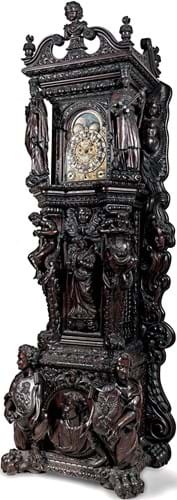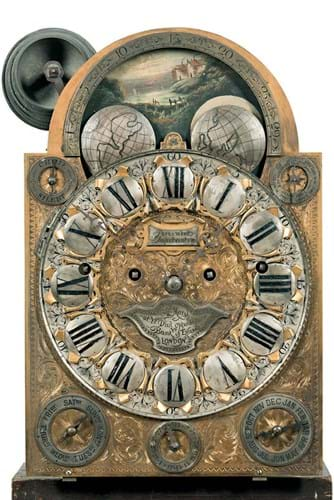Although ‘dated’ MDCCXX (1720) and inscribed Alfd Marsh at ye Dial Opposite ye Bank of England London, in both design and technology it can have been only made in the late Victorian era.
The oak case, 12ft (3.66m) high x 4ft wide (1.22m) x 3ft (90cm) deep, features a riot of three-dimensional carved decoration that amounts to a celebration of the reign of Queen Anne and the Hanoverian succession.
Anne appears prominently to the trunk holding orb and sceptre, alongside similar figures of the Duke of Marlborough, the Archbishop of Canterbury and George I.
Roundels of Milton and Homer adorn the sides while a door to access the pendulum opens to reveal the inscription 1702 Ye Goode Queen Anne and records of the victories at Gibraltar and Blenheim in 1704.
Although of anonymous manufacture, the massive four-train movement is of exceptional quality, driving both a moon phase and a triple calendar while marking the quarters with Westminster and Cathedral chimes.
A musical movement with two sets of bells and a cylinder plays seven songs – one for each day of the week – including singalong favourites such as Johnny’s So Long At The Fair and Auld Lang Syne.
For some years this monster adorned the interior of the Grosvenor Hotel in Chester until it was admired there by a visiting American politician, Percival W Clement (1846-1927). As detailed in an archive of paperwork sold with the clock, he made arrangements to purchase it in 1914 as a conversation piece for a hotel he owned in New York.
In fact, as it turned out, the First World War delayed its transport to the US until 1920, by which time Clement was serving as governor of Vermont. He chose to install it in the State House at Montpelier and there it remained until 1944 when Clement's heirs formally donated it to the Vermont Historical Society.
The archive suggests that some excited researchers deemed it an ancient survivor from the Old World.
A number of similar pastiches reside in US collections, some of them acquired by American industrialists from the British firms who displayed their most flamboyant wares at the international exhibitions. In 2008 the Alderfers saleroom in Pennsylvania sold a clock of very similar movement and dimensions carved with figures from the tale of Dick Whittington and spuriously signed on the dial Joshua Hampson fecit 1743. Back then it took $310,000 (£168,000) plus premium.
The so-called Clement Clock was offered for sale by Skinner in Marlborough in a very different era in terms of both collecting fashion and circumstance.
However, proving such things still have their appeal to the American market, it improved on the estimate of $20,000-40,000 at Skinner to bring $80,000 (£61,500) plus 25% buyer’s premium from a US collector. It was part of an online-only sale of Clocks, Watches & Scientific Instruments which closed on April 15. The proceeds will benefit the Vermont Historical Society.
















